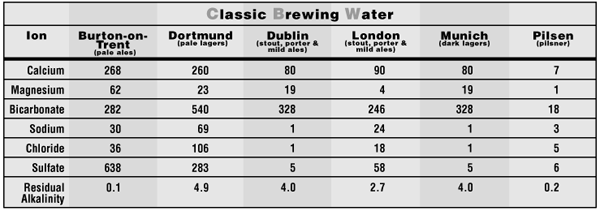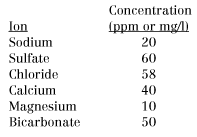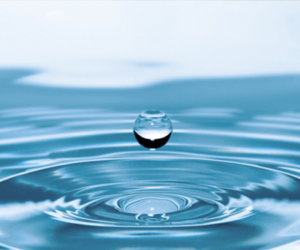Brew Beer that Matches Your Water
Once upon a time, brewers created beer styles by matching local ingredients. Hops were scarce in rocky Scotland, so Scottish ales are malty and lightly hopped. Local microflora in certain valleys in Belgium gave unique and interesting flavors to beer and became incorporated as the most important contributor to the lambic beer styles.
Today, malted barley, hops, and yeast are all traded on the global market. In any region of the United States, it’s easy to find malts from Canada, England, Belgium, Germany, and even Australia. Hops from North America, the United Kingdom, Europe, and even parts of New Zealand and Australia are also readily available.
These raw materials are used in breweries brewing an incredible selection of ales and lagers. Some lager breweries proudly use new equipment made in the United States for microbrewers, who for the most part brew ales. Some ale brewers use beautiful copper brewhouses that were plucked out of traditional German lager breweries.
The notion that lagers are made using undermodified German malts, German hops, and decoction mashing is true in very few new breweries. Likewise, the traditional ale brewed from overmodified, floor-malted (steeped barley spread on a flat surface to germinate) British malt and hops from the county of Kent is not the easiest beer to find.
The fact is that the global economy we live in today has permanently changed the concept of “brewed locally.” In truth the only local ingredient in beer is our water. This premise is even tested in some areas of the country that import water from distant areas or modify local water to be something it is not. For example Los Angeles water is piped hundreds of miles from the Sierra Nevada mountains in Northern California. At the Anheuser-Busch brewery in Northern California, water is modified to be more akin to St. Louis water.
Since water is the only ingredient that can truly be called local in most beers, it makes sense to match all of these wonderful raw materials from around the world to the water in your town. This philosophy is the exact opposite of adding some “Burton salts” to water in order to brew a Burton-style India pale ale.
Instead, don’t tamper with your local water, except to remove chlorine, once you determine the style of beer for which your local water is best suited. This doesn’t mean that you can’t adjust the water for the occasional stout if you live in Pilsner County USA. But it does mean that when you brew a Pilsner, you have brewed something truly representative of the locale in which you live.
Water Basics
Water is important to the brewer for two key reasons:
1. It affects mash and wort pH.
2. It can add ions to beer that affect flavor.
The fact that water affects mash pH is extremely important because the enzymes in malt responsible for the conversion of starch to fermentable sugars function best over a relatively narrow pH range, about 5.2 to 5.6 (for more on pH, see pH Basics, page 55). Mash pH is also important during sparging, because the extraction of astringent husk constituents (tannins or polyphenols) increases the higher the pH.
Wort pH increases as the specific gravity decreases over the course of wort collection. Once the wort has all been collected and the boil commences, the impact of pH is again evident because color and flavor development and hop utilization all depend upon pH level. In general these reactions in the kettle increase with higher pH.
Although pH influences all of the key reactions that occur in wort production, the practical brewer does not attempt to change pH to optimize each pH-dependent reaction. Rather, he is mainly concerned about the mash pH and the pH of the last runnings. He is also typically interested in the pH of wort in the kettle, because it can be measured. As long as the mash pH is somewhere between 5.2 and 5.6 and the last runnings pH does not exceed 6, there should be no major problems associated with pH.
Brewers are also very concerned about ions in water — including sulfate, sodium, chloride, and magnesium — that can affect flavor. These ions are associated with flavors ranging from sweet to bitter and palate-drying to body-building. For a complete description of these flavors at various concentrations, see the table below.
pH Reactions
Most waters have two conflicting constituents that affect pH in opposite directions. The calcium and magnesium ions react with phosphate ions in malt to decrease mash and wort pH. The carbonate and bicarbonate ions, on the other hand, act to increase pH, mainly through their ability to “mop up” pH-suppressing hydrogen ions. For the scientifically inclined, Equations 1 through 4 (“A Little Chemistry,” page 52) describe in chemical terms how these reactions work.
The key point to note is that water pH is a very poor indicator of mash pH. Calcium and magnesium do not affect pH until mixed with malt, and even though carbonates and bicarbonates do affect water pH, it is impossible to use their effect on water pH to predict their effect on mash pH.
The most important indicator of how these various ions affect mash pH comes from comparing their concentrations. To make this comparison, you need an analysis of your local water. This information is available to the public and can be obtained by calling or visiting your local water company.
Once you obtain a water analysis, it’s time to begin determining what type of water you have. The following example has been taken from a much longer list of numbers, but the concentrations listed are the most important to brewers.
The first factors to examine are the levels of sodium, sulfate, and chloride. In this sample water, they are all relatively low (in fact the concentrations are similar to those found in London water). The second and most important step is to evaluate the three ions that affect pH: calcium, magnesium, and bicarbonate.
Unfortunately, this requires a couple of calculations. On its own, the concentration information provided by the water company is not very useful because concentration is expressed in milligrams per liter, which is the weight of the ion per volume of water. But the ability of calcium, for example, to lower pH depends on how many calcium charges are in solution, not on the weight of calcium in solution. Fortunately, these factors are related by a term called “equivalent weight,” which accounts for the ion’s charge and its molecular weight.
Step 1: Convert concentration (parts per million or milligrams per liter) to millivals.
A millival, or mval, is an expression of charge concentration and is simply the concentration of a given ion in milligrams per liter divided by the ion’s equivalent weight (which is constant). The Conversion to Millivals table at right lists the concentration of calcium, magnesium, and bicarbonate, their equivalent weights, and the mval of these three ions.
Remember, these are the only three ions found in water that affect mash and wort pH. The mval concentration of these three ions is important in determining how the pH will be
affected by the water. To evaluate your local water simply replace the “concentration in water” values in the table with your water values and divide by the respective equivalent weight to determine mval.
Step 2: Calculate the residual alkalinity of the water.
Bicarbonates increase pH and are said to be alkaline in nature. When the effects of bicarbonate ions at increasing pH outweigh the effects of calcium and magnesium ions at decreasing pH, water is said to have a positive residual alkalinity. Bicarbonate ions are about 3.5 times more effective at increasing mash pH than calcium ions are at lowering it, and seven times more effective than magnesium at lowering pH. Thus, the mval concentrations must be equilibrated. This allows the brewer to truly determine which system is the most dominant. The following equation can be used to calculate residual alkalinity:
Residual alkalinity = mval bicarbonate – (mval Ca/3.5 + mval Mg/7).
For the example water this equation becomes:
Residual alkalinity = 0.82 – (2/3.5 + 0.83/7) = 0.13
This means the sample brewing water has a slightly positive residual alkalinity (RA). Compared with the RA of brewing cities around the world, this water is definitely suited for pale beers rather than dark beers. Although the water does have some chloride, sulfate, and sodium, the levels in the water are far lower than in most famous brewing waters. This water could probably be used for almost any pale beer, ale, or lager, and for amber and light brown beers with low levels of roasted malts.
If too much dark malt is used in mashing and the water has a low RA like the sample water, then the mash pH can be too low. This can interfere with the enzymes in the mash, lend acidic grain flavors to the beer, and decrease hop utilization in the kettle. This is why pale beers flourished in cities with this particular type of water.
Note that few cities around the world, and not just the selection in Classic Brewing Water (page 51), have low RA waters. This fact partially explains why pale beers were uncommon until methods of brewery water treatment became popular during the latter part of the 19th century. Also, very pale malts, like those routinely used today, did not exist until the early 1800s. For these reasons most cities could make good dark beers, which worked out great because pale malts were uncommon until recent times.
When waters have a high RA, as do Munich and Dublin municipal waters, the mash pH tends to be increased. However, the malts used in these towns were historically very acidic and balanced out the alkalizing effects of the water. Thus stout, which contains high proportions of roasted barley, is best brewed with alkaline waters.
Dortmund, on the other hand, has a high RA but is famous for pale lagers. Traditionally, Dortmund brewed dark wheat ales but switched to bottom-fermented lagers in the mid-1800s. These pale beers required water treatment because of the high water alkalinity. Boiling prior to use was most likely the water-treatment method of choice.
Matching Water to Beer
The next step is to apply the methods discussed above to matching beer style to water chemistry. The best way to see how this works is to determine the RA of your local brewing water and compare it to that of the famous brewing waters in the table on page 51.
Take note of the other ions in your water, such as sodium, chloride, and sulfate, too, because they affect flavor. One point to remember when doing this is that there are essentially three types of brewing water: dark beer water, pale beer water, and very pale beer water. Once the water is loosely pigeon-holed, it is then up to you, the brewer, to empirically determine the best use for the water within these broad categories.
The best result of such experimental homebrewing is making your local brewing water an essential ingredient for your homebrew. Who knows, maybe a new and exciting beer style can come from your town!
A Little Chemistry: How ions affect mash pH
Calcium and magnesium have similar effects on mash pH in that they both react with phosphate from malt to form an insoluble precipitant (solid). These reactions cause a release of hydrogen ions. This causes pH to decrease, because pH is a function of the hydrogen ion concentration. As the hydrogen ion concentration increases, pH decreases (acidity increases).
In reality calcium is a more powerful acidifying ion than magnesium, because its phosphate salt (Ca3(PO4)2) is less soluble than the phosphate salt of magnesium (Mg3(PO4)2). It is the precipitation of the phosphate salt that drives the liberation of hydrogen ions from malt phosphates.
Reaction 1:
3 Ca+2 + 2HPO4-2 →
2H+ + Ca3(PO4)2 (precipitant)
Reaction 2:
3 Mg+2 + 2HPO4-2 →
2H+ + Mg3(PO4)2 (precipitant)
The discussion of water chemistry must include mention of both carbonate and bicarbonate ions. Both of the ions affect water pH. However, the carbonate ion is never present in a brewery mash, because the mash pH is too low to permit its existence. Instead, all carbonates are present as bicarbonate.
The bicarbonate ion is able to react with hydrogen to form carbonic acid (H2CO3), which then decomposes to carbon dioxide and water. This causes an increase in pH, because hydrogen ions are removed from water (see Reaction 3).
When mash water is boiled prior to mashing, a common method of removing carbonates, the carbonate ion is present and can react with calcium to form an insoluble salt (see Reaction 4). These are the key reactions that govern mash and wort pH.
Reaction 3:
HCO3- + H+ →
H2CO3 + Heat →
H2O + CO2
Reaction 4:
Ca+2 + CO3-2 →
CaCO3 (precipitant)
pH Basics
pH is an indicator of the acidity or alkalinity of liquids. It is directly related to the hydrogen ion concentration. Solutions that have a pH less than seven are acidic. Solutions that have a pH greater than seven are alkaline and are referred to as bases.
Mathematically pH is: -log[H+], or the negative logarithm of the molar hydrogen concentration. This means as the concentration of the hydrogen ion increases, the pH decreases; this is why an increase in acidity (hydrogen ion concentration) causes pH to drop.





